#hooded warbler
Text

Hooded warblers
By: Arthur A. Allen
From: The Book of Bird Life
1961
26 notes
·
View notes
Text
BOTD: Hooded Warbler

Photo: Doug Greenberg
"In the forest undergrowth, this skulking warbler seems to call attention to itself by frequently fanning its tail quickly open and shut, flashing the white outer tail feathers. Hooded Warblers are common in moist leafy woodlands of the Southeast. They usually stay low in the shadowy understory, foraging actively in the bushes and nesting close to the ground, although males will move up into the trees to sing."
- Audubon Field Guide
#birds#hooded warbler#birds of north america#north american birds#warblers#passerines#wood warblers#birds of the us#birds of mexico#birds of central america#birds of the caribbean#birds of canada#birding#birdblr#birblr#bird watching#bird of the day#Setophaga citrina
76 notes
·
View notes
Text
Warbler Showdown; Bracket 1, Poll 2


Hooded Warbler (Setophaga citrina)
IUCN Rating: Least Concern
Range: Eastern USA during the breeding season, preferring the Appalachain and Ozark mountains; almost entirely conentrated on the Yucitan penninsula when overwintering.
Habitat: mature deciduous forests, preferring areas with significant treefall gaps.
Myrtle Warbler (Setophaga coronata)
IUCN Rating: Least Concern
Range: Entirely North American; typically associated with the Eastern US, but does make it into the Western states during migration and for overwintering.
Habitat: mature coniferous and mixed coniferous-deciduous forests in the breeding season, preferring mountain forests when possible. When overwintering, they can be seen virtually anywhere small fruits like berries are present.
Image Sources: Hooded (Ryan Sanderson); Myrtle (Ed Harper)
#NWW Showdown#hooded warbler#myrtle warbler#yellow rumped warbler#setophaga#parulidae#animal poll#bird poll
74 notes
·
View notes
Photo

Hooded Warbler
86 notes
·
View notes
Photo






Early morning in Edmonson County, Kentucky
Taken July 2022
159 notes
·
View notes
Text
During the breeding season, male Hooded Warblers establish and defend territories, attracting mates with whom they usually form pair-bonds.
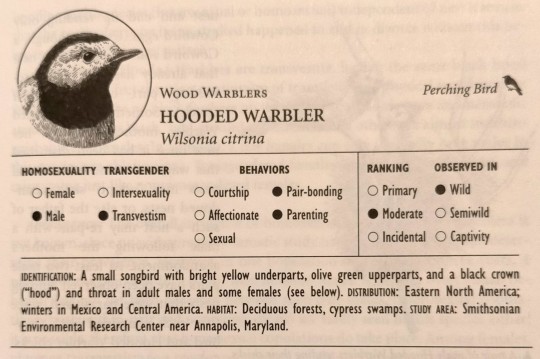
"Biological Exuberance: Animal Homosexuality and Natural Diversity" - Bruce Bagemihl
#book quotes#biological exuberance#bruce bagemihl#nonfiction#hooded warbler#wilsonia citrina#breeding season#pair bonding
10 notes
·
View notes
Text

Hooded Warbler takes a gnat at Evodia ,Ramble ,Central park.
#birdsinflight #flyingbirds #birds_in_flight #hoodedwarbler @BirdCentralpark #warbler
53 notes
·
View notes
Photo

Bird portraits for ‘This Is a Book for People Who Love Birds’ published by Running Press.
#art#Illustration#artists on tumblr#birds#acorn woodpecker#hooded warbler#california condor#prairie chicken
18 notes
·
View notes
Text
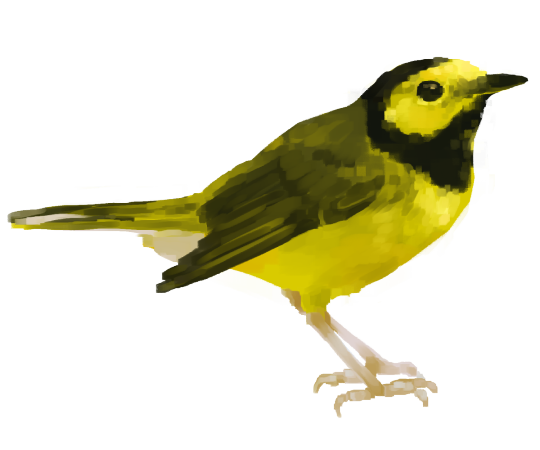
hooded warbler (setophaga citrina)
16 notes
·
View notes
Text

4 notes
·
View notes
Text


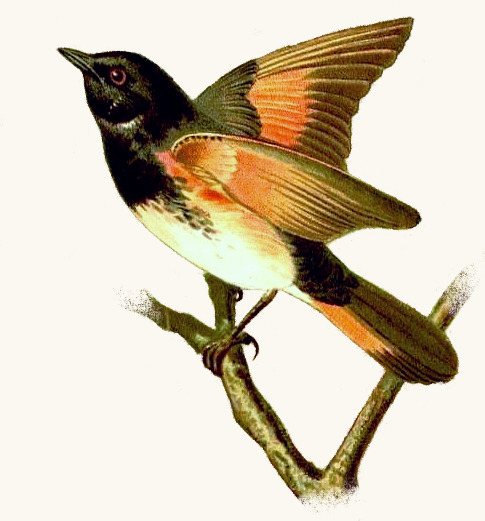
Geothlypis formosa
Kentukcy warbler
Setophaga citrina
Hooded warbler
Setophaga ruticilla
American redstart
Gustav Mützel, Die Nordamerikanische Vogelwelt, via Flickr
#kentucky warbler#hooded warbler#american redstart#gustav mutzel#public domain#passerines#aves#illustration#parulidae#geothlypis formosa#geothlypis#setophaga#setophaga ruticilla#setophaga citrina
20 notes
·
View notes
Text
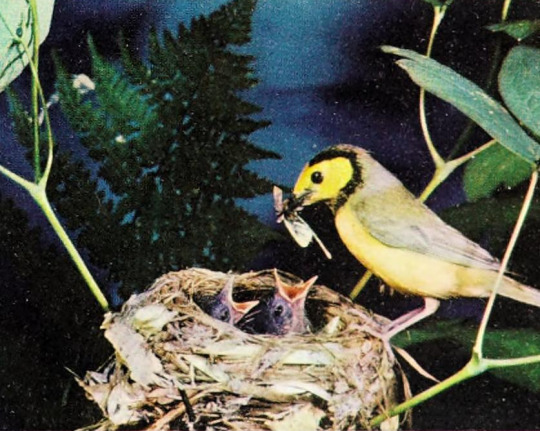
Hooded warbler
By: Arthur A. Allen
From: The Book of Bird Life
1961
#predation#hooded warbler#warbler#passeriform#bird#1961#1960s#Arthur A. Allen#The Book of Bird Life (1961)
92 notes
·
View notes
Text

0 notes
Text
Genus: Setophaga
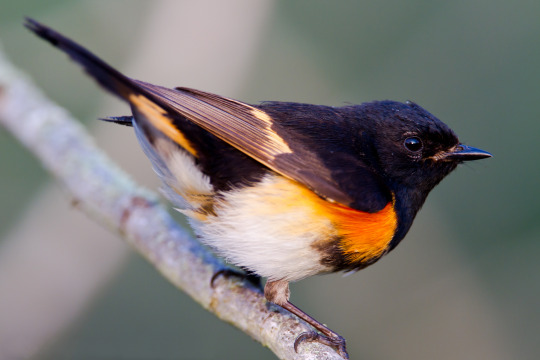
Originally, this genus was only used for the American Redstart (Setophaga ruticilla). Meaning 'moth-eater', it was used to refer to the flycatcher-like habits of the American Restart, which sallies forth from a perch to catch flying insects rather than plucking them from vegetation.
In 2010, however, a newly published paper disrupted what was thought of Parulidae taxonomy. Using a comprehensive molecular phylogenetic analysis of the family, several genus were merged into Setophaga. Not only that, but a separate genus of warbler was cleaved in two based on the findings.
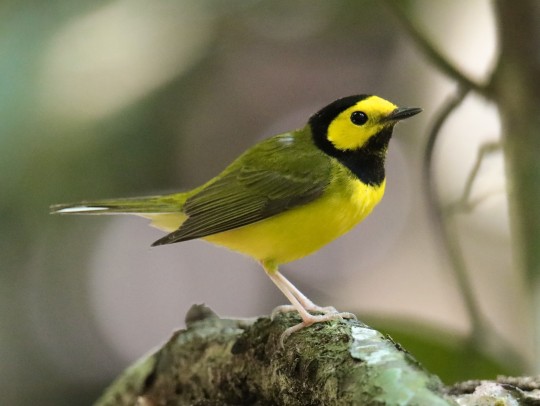
The Hooded Warbler was previously listed under the genus Wilsonia along with Wilson's Warbler and Canada Warbler. They had even been in an obsolete genus together before this (Sylvania), though this was changed to Wilsonia for other reasons. The 2010 study showed that Wilsonia was polyphyletic, meaning the group may share similar traits, but do not share a common ancestor. Hooded Warbler was moved to Setophaga and Wilson's and Canada Warbler were placed into Cardellina, an existing genus with Red-faced, Pink-headed, and Red Warbler.

The two Parula species were also folded into Setophaga as a result of the 2010 study. The Northern and Tropical Parula were originally the only two members of this genus, with the Northern Parula being the type-specimen of New World Warblers as a whole. I find that a bit ironic, as they are one of the smallest warblers and show quite an unusual color patter when compared to the rest of Parulidae, but I don't exactly know how type-specimen are chosen.

The largest genus to be merged with Setophaga was Dendroica. When I first began learning species names, I was familiar with this as the genus for most warblers. Due to the way taxonomic names work, the name which was published first takes precedent in these merging scenarios. So, despite the fact Dendroica had around 30 species and Setophaga had just 1, Setophaga was published first in 1827 (Dendroica in 1842).
In summary, Setophaga went from just a single species to now being the largest in the Parulid family, holding 34 species!
Image Sources: AMRE (Dan Pancamo); HOWA (Ninahale); NOPA (Dan Pancamo); MAWA (Cephas)
#setophaga#parulidae#passeriformes#bird#north american birds#american birds#american redstart#hooded warbler#northern parula#magnolia warbler#(had to include MAWA in there they're babyyyy)#(also hi I'm wikipedia now I guess. linking to other wiki pages within my own article like damn lol)#Genus Feature
39 notes
·
View notes
Photo
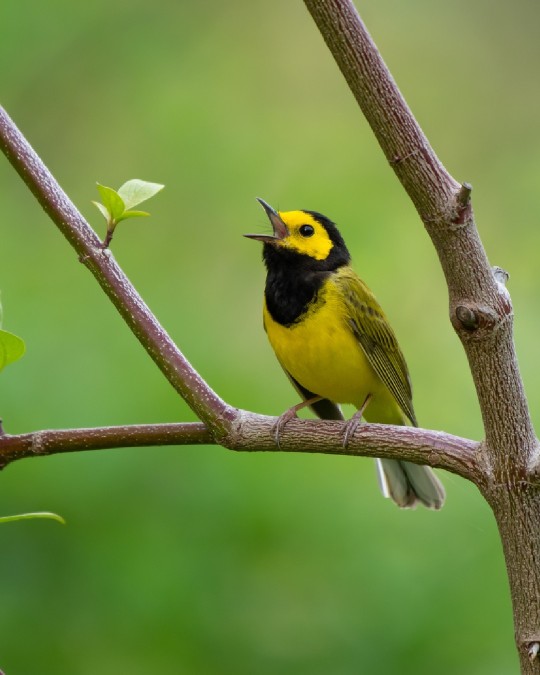
Hooded Warbler
263 notes
·
View notes
Text
These males often perform parenting duties typically associated with females in heterosexual pairs.
"Biological Exuberance: Animal Homosexuality and Natural Diversity" - Bruce Bagemihl
#book quote#biological exuberance#bruce bagemihl#nonfiction#hooded warbler#wilsonia citrina#parenting
0 notes